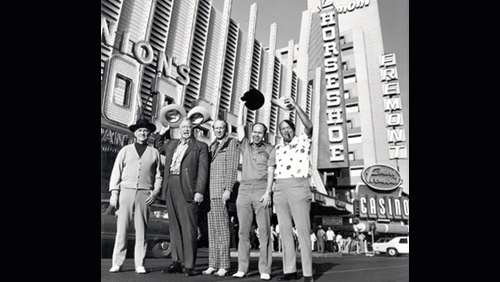The life of Johnny Moss was a unique one – both within poker as a game and purely about the man himself. The first-ever winners of the WSOP Main Event, a poker pioneer, and one of the charter inductees into the Poker Hall of Fame, Johnny Moss is a name that is and forever will be synonymous with the game of poker.
Who was Johnny Moss really, though? Where did he come from and how close did he come to giving up before becoming a three-time world champion? The truth might surprise you.
Old Before His Time
Johnny Moss was nicknamed The Grand Old Man of Poker, but in truth, he was older coming to the game professionally purely because poker wasn’t a viable profession in any sense of the world. Born in 1907, his teens were spent during the era of the first World War and his thirties were spent during the Second World War.
Based in Dallas, Johnny Moss got his first taste of poker working at a local saloon as a boy, watching over games to keep them clean. Having been taught some of the nefarious ‘dark arts’ of the game, Moss knew exactly what to look out for. In the 1940’s, the war might have killed some of the action, but after Hitler was dead, Moss would become a gambling man full-time. Texas Hold’em was exactly what Moss played, and in Texas too, becoming part of the scenery in the state.
Taking the Greek to Town
In 1949, Johnny Moss began a heads-up game against a player known as ‘Nick the Greek’. While debate still fizzles about the location – it could have been The Horseshoe, but The Flamingo is touted as more likely – the game lasted five whole months, the legendary heads-up marathon ended with Moss up anywhere between $2 million and double that. It also ended with Nick the Greek’s famous words to his opponent, “Mr. Moss, I have to let you go.” symbolising just how dominant Moss had been.
Despite this success – the game would eventually become the subject of Al Alvarez’s book, The Biggest Game in Town – it would not be until 1970 that the World Series of Poker came along. During the time in between, Moss seriously considered giving up gambling – and cards – altogether, but despite that, was pulled back to poker just in time.
Winning the 1970 WSOP Main Event was easy – no game was played at all as it was done by ballot. We say easy, but the first vote saw each man vote for himself, so it took a second vote where that wasn’t possible to give the title – and a silver cup – to The Grand Old Man of Poker. In 1971, the very next year, Moss would win it again, this time winning a six-handed game to do so and winning with – appropriately enough – pocket sixes. That he would go two years without winning it was not so strange, the competition may have been numerically low, but the only players in the game were tougher than a pair of cowboy boots. There were 16 players who played in 1974, when Moss won his record third WSOP Main Event. Of all the players ever to play the WSOP Main Event, the only two who have won in three times are Johnny Moss and Stu Ungar.
A Lasting Legacy
Johnny Moss didn’t confine his World Series titles to Main Events, however, winning an additional six titles to leave his legacy in WSOP bracelets at nine, a total only bettered by four men in poker history. He also set the record for becoming the oldest bracelet winner, when, aged 81, he took down the 1988 $1,500-entry Ace to Five draw event, winning $116,400.

Over the course of his incredible career, Johnny Moss won an amazing $1.25 million at the poker felt in tournaments alone – by today’s standards, a ridiculous amount of money if you account for inflation. He did so with a swagger and a smile, and a doff of his hat and his last cash came at the age of 88 in 1995, the year of his death.
Johnny Moss may have died 25 years ago next week, but his legacy in the game of poker will live forever, a contribution fitting of The Grand Old Man of Poker himself.
Johnny Moss (far left) outside Binions and the Horseshoe in Las Vegas, Nevada (1974)
